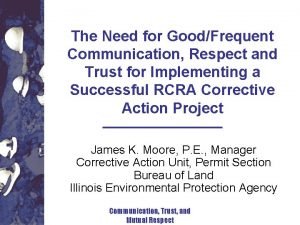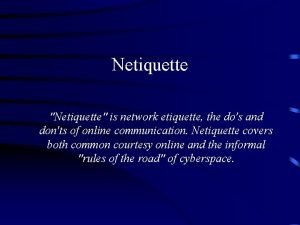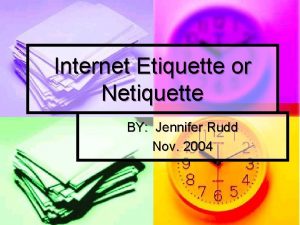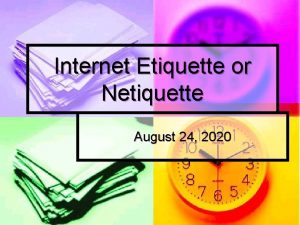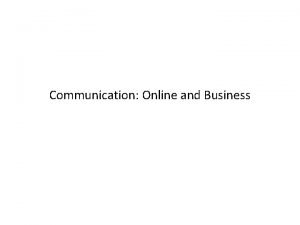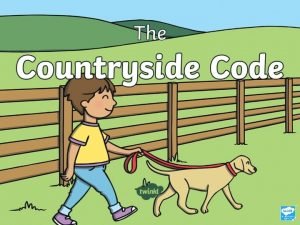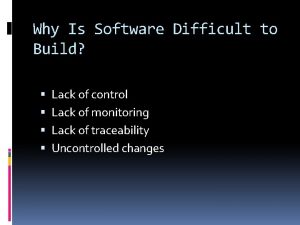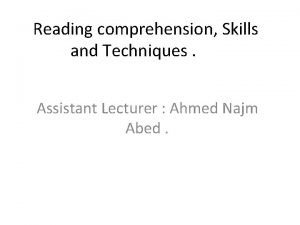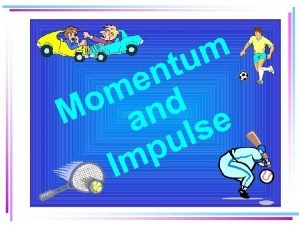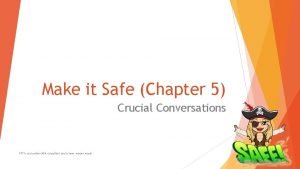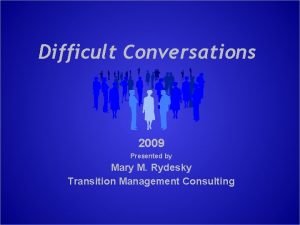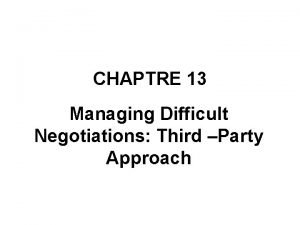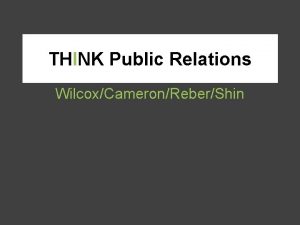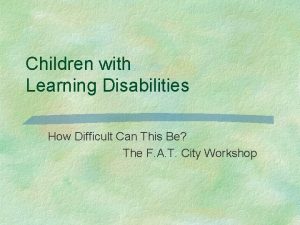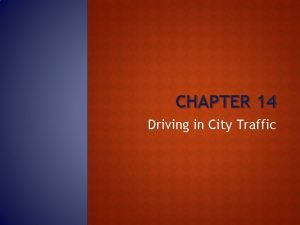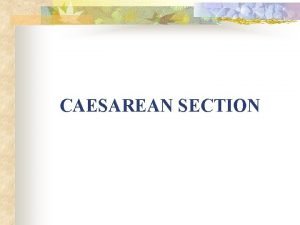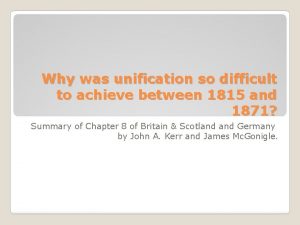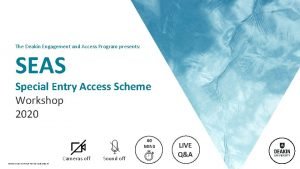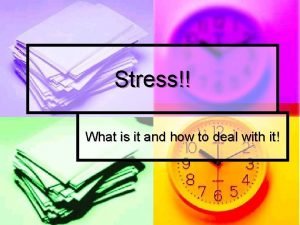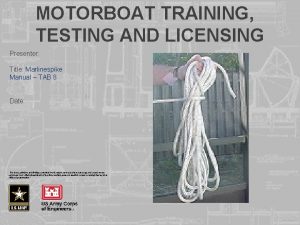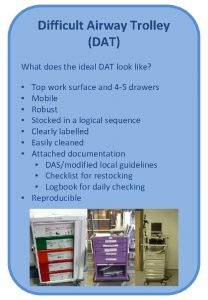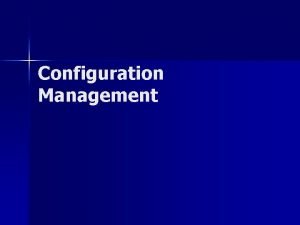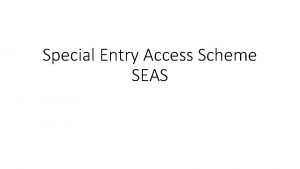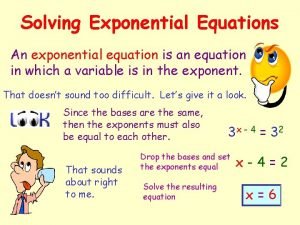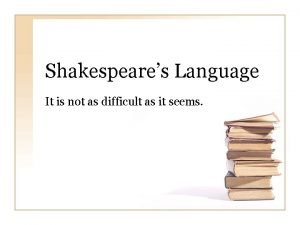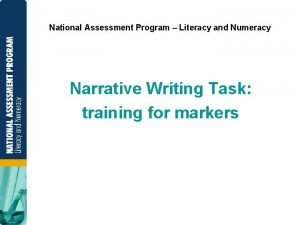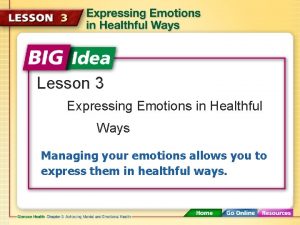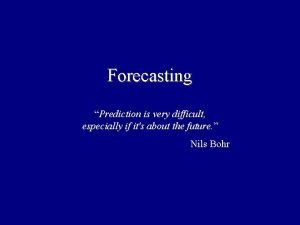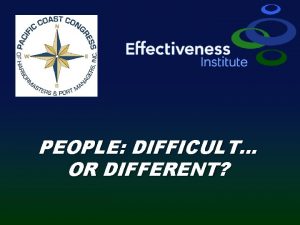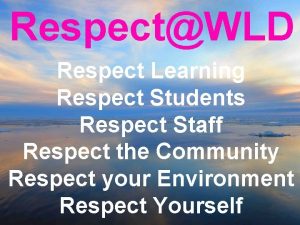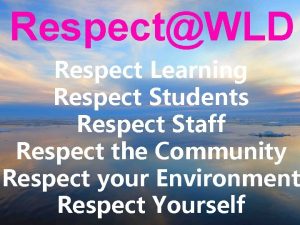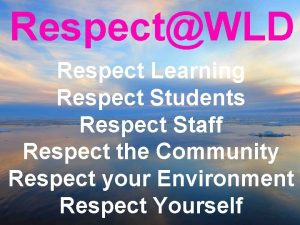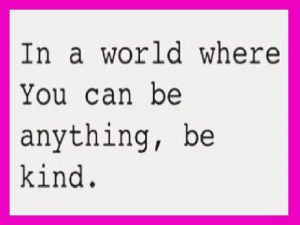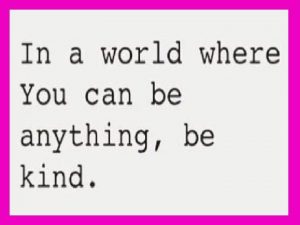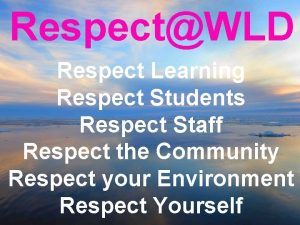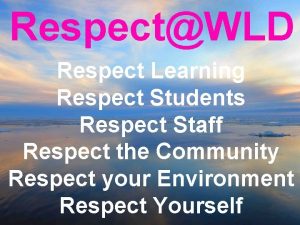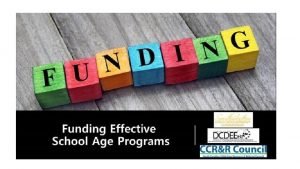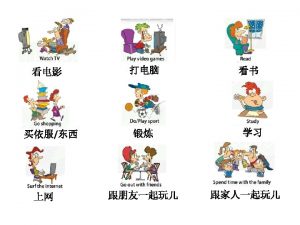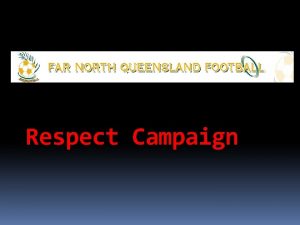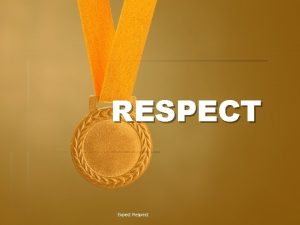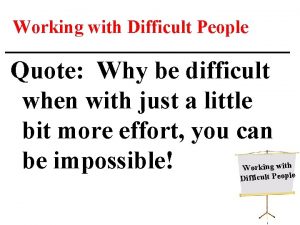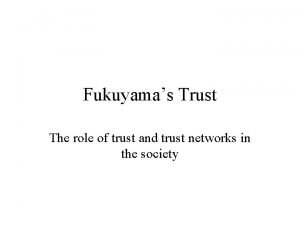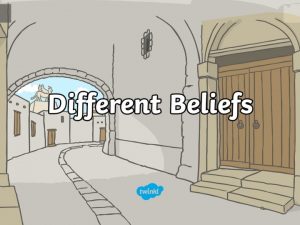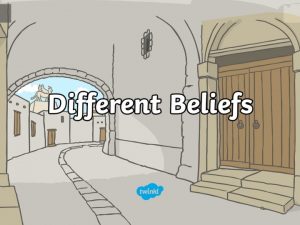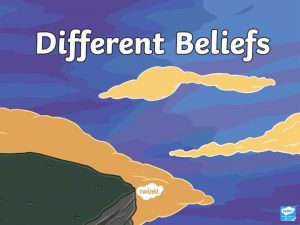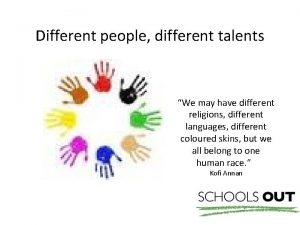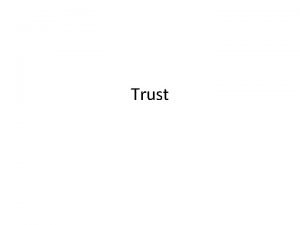PEOPLE DIFFICULT OR DIFFERENT TRUST AND RESPECT People





















































- Slides: 53

PEOPLE: DIFFICULT… OR DIFFERENT?

TRUST AND RESPECT People Tasks People

Perceptions (Values) Beliefs Behavior

ICEBERG Choice Observable Behavior Total Personality

BEHAVIOR VS. PERSONALITY is who you are. BEHAVIOR is what you do. PERSONALITY cannot be situationally, intentionally and temporarily modified by choice. BEHAVIOR can be situationally, intentionally and temporarily modified by choice.

Patterns of Behavior Choice Observable Behavior Personality Environment Situation

KEY POINTS There are various, common patterns of behavior (i. e. , Behavior Patterns). Behavior Patterns do not define an individual – they describe the behavior they are showing. People change their behavior depending on the situation and environment they are in. Being able to identify the Behavior Patterns of others and respond in a way that makes a positive impact helps build trust and respect.

WHAT’S THE PATTERN? ? If you can identify the pattern you can make sense of it and know what comes next

FOUR LINES OF BEHAVIOR

Think of a specific person that is difficult or challenging for you to work with…

DECISIONS

DECISIONS Fast, Gut

DECISIONS Process

DECISIONS Fast, Gut Process Slow Clinical Indecisive Trust and Respect Bossy Pushy Rude

DECISIONS Process Thoughtful Comprehensive Thorough Fast, Gut Trust and Respect Decisive Courageous Fearless

DECISIONS Process Fast, Gut

DECISIONS Process Fast, Gut

ENVIRONMENT

ENVIRONMENT Stable

ENVIRONMENT Dynamic

ENVIRONMENT Dynamic Impulsive Unfocused Random Trust and Respect Stable Timid Uncreative Boring

ENVIRONMENT Dynamic Trust and Respect Stable Creative Dependable Flexible Consistent Energetic Harmonious

ENVIRONMENT Dynamic Stable

ENVIRONMENT Dynamic Stable

ACCURACY

ACCURACY Right Way

ACCURACY Get it Done

ACCURACY Get it Done Careless Sloppy Reckless Trust and Respect Right Way Rigid Uptight Obsessive

ACCURACY Get it Done Trust and Respect Right Way Big Picture Precise Shrewd Defined Ingenious Truthful

ACCURACY Get it Done Right Way

ACCURACY Get it Done Right Way

PEOPLE

PEOPLE Socially Assertive

PEOPLE Socially Cautious

PEOPLE Trust and Respect Insecure Fearful Stuck-up Socially Cautious Dramatic Shallow Egotistical Socially Assertive

PEOPLE Trust and Respect Restrained Humble Reserved Socially Cautious Confident Self-assured Outgoing Socially Assertive

PEOPLE Socially Cautious Socially Assertive

PEOPLE Socially Cautious Socially Assertive

2 and 2 PATTERN 1 Decisions Environment Accuracy People

PATTERN 3 Decisions Environment Accuracy People

PATTERN 4 - LEARNED BALANCE Decisions Environment Accuracy People

PATTERN 5 - SITUATIONALLY APPROPRIATE Decisions Environment Accuracy People

INTENT AND IMPACT INTENT Our behavior makes an IMPACT. When our IMPACT is positive, trust and respect increase. C I X When our IMPACT is negative, trust and O T respect decrease.

TWO KEY POINTS 1. We need to know our IMPACT. People guess our INTENT based upon our IMPACT so… Even if our INTENT is positive our IMPACT can be negative. 2. We can choose behaviors that create positive IMPACT.

FROM FOUR TO TWO LINES To make behavior pattern information easier to remember and apply, we convert the four lines to two lines. This creates a four quadrant model that identifies an individual’s behavior pattern. We call these four different patterns Behavior Styles.

RESULTS How do you tend to go about getting things done? PROCESS RESULTS Process focused individuals tend to take a more systematic approach to their work and are concerned with how the work is done. EXPEDIENCE Expedience focused individuals tend to take a “big-picture” approach to their work and are concerned with how quickly work is done.

EMOTIONS How do you tend to interact with others? CONTROLLED E M O T I O N S RESPONSIVE Controlled individuals tend to limit the amount of emotion they show and focus energy on what the work is. Responsive individuals tend to easily express their emotions and focus energy on the people involved in and doing the work.

BEHAVIOR STYLES CONTROLLED P R O C E S S A Analyzer E M O T I O N S C Controller RESULTS S Stabilizer RESULTS E M O T I O N S P Persuader RESPONSIVE E X P E D I E N C E

QUICK PROFILE Tends to do more listening than talking; seems to allow others to initiate and carry conversations P or E Tends to do more talking than listening; seems to enjoy initiating and carrying a conversation Appears to use facial expressions freely and easily; seems to frequently smile, nod or frown R or C Appears to limit facial expressions; does not seem to frequently smile, nod or frown Actions seem careful or deliberate; most comfortable dealing with objective facts or detailed information C or R Actions seem spontaneous and eager; most comfortable dealing with opinions and feelings Tends to look away often and lean back while having a conversation P or E Tends to make direct eye contact and lean forward while having a conversation Speaks in a fast-paced manner; rarely seems to pause while speaking E or P Speaks in a thoughtful and slower-paced manner; seems to pause frequently while speaking Focuses on accomplishing work; attention seems to be on involvement with tasks C or R Focuses on relationships; attention seems to be on involvement with people Gestures freely and frequently; actions seem to be spontaneous and animated R or C Limited use of gestures; actions seem to be careful and deliberate States personal needs, expectations and opinions more often than asks questions about others’ needs E or P Asks questions about others' needs more often than states personal needs, expectations and opinions Appears to avoid arguments and energetic debate P or E Appears to enjoy arguments and energetic debate C or R Shares personal feelings and emotions openly; seems to enjoy personal story-telling and selfdisclosing small talk Shares very little of personal feelings and emotions; seems to limit personal story-telling or self-disclosing small talk

QUICK PROFILE Tends to do more listening than talking; seems to allow others to initiate and carry conversations Appears to use facial expressions freely and easily; seems to frequently smile, nod or frown P or E Tends to do more talking than listening; seems to enjoy initiating and carrying a conversation R or C Appears to limit facial expressions; does not seem to frequently smile, nod or frown

QUICK PROFILE CONTROLLED P 5 P 4 P 3 P 2 P 1 E 2 E 3 E 4 E 5 P= C= R= E= 3 1 4 2 P R O C E S S C 5 • • • C 5 C 4 • • • C 4 C 3 • • • C 3 C 2 • • • C 2 C 1 • • • C 1 R 1 • • • R 1 R 2 • • R 3 • • R 4 • • P R 5 • • A S C • • • R 2 • • • R 3 • • • R 4 • • • R 5 P 4 P 3 P 2 P 1 E 2 E 3 E 4 E 5 RESPONSIVE E X P E D I E N C E


THANK YOU! Lisa Bresnahan lisa@effectivenessinstitute. com
 Communication trust and respect
Communication trust and respect Things that make us different
Things that make us different Charitable work
Charitable work How to deal with difficult people
How to deal with difficult people Tabitha espina
Tabitha espina Respect other people’s time and bandwidth
Respect other people’s time and bandwidth Internet etiquette or netiquette
Internet etiquette or netiquette Respect other people's time and bandwidth
Respect other people's time and bandwidth Business netiquette rules
Business netiquette rules Respect people who live and work in the countryside
Respect people who live and work in the countryside Why do different polymers have different properties?
Why do different polymers have different properties? Flame test principle
Flame test principle Sound will travel at different speeds in different mediums.
Sound will travel at different speeds in different mediums. Library thinkquest org 19537
Library thinkquest org 19537 What is cultural relativism
What is cultural relativism Different angle different story
Different angle different story Acids and bases song
Acids and bases song Different materials have different
Different materials have different Argumenterande tal struktur
Argumenterande tal struktur What are the characteristics of people media?
What are the characteristics of people media? What makes a good college application
What makes a good college application Why software difficult to build
Why software difficult to build Beaumol
Beaumol The way of the transgressor is hard esv
The way of the transgressor is hard esv You can easily forget how different life was 50 years ago.
You can easily forget how different life was 50 years ago. In a stressful situation feelings of pain are dulled by
In a stressful situation feelings of pain are dulled by Tell me all about this name that is difficult to say
Tell me all about this name that is difficult to say Paragraph reading
Paragraph reading Momentum is a measure of how difficult it is to
Momentum is a measure of how difficult it is to Crucial conversations ppt
Crucial conversations ppt Difficult conversations role play
Difficult conversations role play Difficult conversation preparation worksheet
Difficult conversation preparation worksheet Managing difficult negotiations
Managing difficult negotiations The most difficult persuasive task is to
The most difficult persuasive task is to How difficult can this be
How difficult can this be Chapter 14 driving in city traffic
Chapter 14 driving in city traffic Economics unit 1 lesson 2 difficult choices
Economics unit 1 lesson 2 difficult choices C section slideshare
C section slideshare Types of difficult conversations
Types of difficult conversations Why was italian unification difficult to achieve
Why was italian unification difficult to achieve Lemon moans airway
Lemon moans airway Category 4 seas
Category 4 seas Dealing successfully with difficult changes in your life
Dealing successfully with difficult changes in your life Used for quick, temporarypost, spar or stake.
Used for quick, temporarypost, spar or stake. Stork law
Stork law Ideal dat
Ideal dat Why is software difficult to build?
Why is software difficult to build? Seas calculator
Seas calculator Something that is difficult to understand
Something that is difficult to understand Solving for exponents
Solving for exponents Thy thou thee
Thy thou thee Difficult words to spell
Difficult words to spell Chapter 3 lesson 3 expressing emotions in healthful ways
Chapter 3 lesson 3 expressing emotions in healthful ways Forecasting is difficult especially about the future
Forecasting is difficult especially about the future
